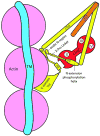The unique functions of cardiac troponin I in the control of cardiac muscle contraction and relaxation
- PMID: 18162178
- PMCID: PMC2365727
- DOI: 10.1016/j.bbrc.2007.12.114
The unique functions of cardiac troponin I in the control of cardiac muscle contraction and relaxation
Abstract
We review development of evidence and current perceptions of the multiple and significant functions of cardiac troponin I in regulation and modulation of cardiac function. Our emphasis is on the unique structure function relations of the cardiac isoform of troponin I, especially regions containing sites of phosphorylation. The data indicate that modifications of specific regions cardiac troponin I by phosphorylations either promote or reduce cardiac contractility. Thus, a homeostatic balance in these phosphorylations is an important aspect of control of cardiac function. A new concept is the idea that the homeostatic mechanisms may involve modifications of intra-molecular interactions in cardiac troponin I.
Figures

Similar articles
-
Troponin: regulatory function and disorders.Biochem Biophys Res Commun. 2008 Apr 25;369(1):62-73. doi: 10.1016/j.bbrc.2007.11.187. Epub 2007 Dec 26. Biochem Biophys Res Commun. 2008. PMID: 18154728 Review.
-
Troponin and cardiomyopathy.Biochem Biophys Res Commun. 2008 Apr 25;369(1):74-81. doi: 10.1016/j.bbrc.2007.12.081. Epub 2007 Dec 26. Biochem Biophys Res Commun. 2008. PMID: 18157941 Review.
-
Cardiac myosin regulatory light chain kinase modulates cardiac contractility by phosphorylating both myosin regulatory light chain and troponin I.J Biol Chem. 2020 Apr 3;295(14):4398-4410. doi: 10.1074/jbc.RA119.011945. Epub 2020 Feb 21. J Biol Chem. 2020. PMID: 32086378 Free PMC article.
-
Troponin I Mutations R146G and R21C Alter Cardiac Troponin Function, Contractile Properties, and Modulation by Protein Kinase A (PKA)-mediated Phosphorylation.J Biol Chem. 2015 Nov 13;290(46):27749-66. doi: 10.1074/jbc.M115.683045. Epub 2015 Sep 21. J Biol Chem. 2015. PMID: 26391394 Free PMC article.
-
Cooperative effects due to calcium binding by troponin and their consequences for contraction and relaxation of cardiac muscle under various conditions of mechanical loading.Circ Res. 1991 Nov;69(5):1171-84. doi: 10.1161/01.res.69.5.1171. Circ Res. 1991. PMID: 1934350
Cited by
-
Structural dynamics of troponin I during Ca2+-activation of cardiac thin filaments: a multi-site Förster resonance energy transfer study.PLoS One. 2012;7(12):e50420. doi: 10.1371/journal.pone.0050420. Epub 2012 Dec 5. PLoS One. 2012. PMID: 23227172 Free PMC article.
-
Myofilament dysfunction in cardiac disease from mice to men.J Muscle Res Cell Motil. 2008;29(6-8):189-201. doi: 10.1007/s10974-008-9160-y. Epub 2009 Jan 13. J Muscle Res Cell Motil. 2008. PMID: 19140019 Review.
-
Small molecule AKAP-protein kinase A (PKA) interaction disruptors that activate PKA interfere with compartmentalized cAMP signaling in cardiac myocytes.J Biol Chem. 2011 Mar 18;286(11):9079-96. doi: 10.1074/jbc.M110.160614. Epub 2010 Dec 22. J Biol Chem. 2011. PMID: 21177871 Free PMC article.
-
Overview of the Muscle Cytoskeleton.Compr Physiol. 2017 Jun 18;7(3):891-944. doi: 10.1002/cphy.c160033. Compr Physiol. 2017. PMID: 28640448 Free PMC article. Review.
-
Dissecting human skeletal muscle troponin proteoforms by top-down mass spectrometry.J Muscle Res Cell Motil. 2015 Apr;36(2):169-81. doi: 10.1007/s10974-015-9404-6. Epub 2015 Jan 23. J Muscle Res Cell Motil. 2015. PMID: 25613324 Free PMC article.
References
-
- Ebashi S, Kodama A. A new protein factor promoting aggregation of tropomyosin. J Biochem. 1965;58:107–108. - PubMed
-
- Solaro RJ. Modulation of cardiac myofilament activity by protein phosphorylation. In: Page E, Fozzard H, Solaro RJ, editors. Handbook of Physiology: Section 2. The Cardiovascular System. Vol. 1. Oxford University Press; New York: 2001. pp. 264–300.
-
- Kobayashi T, Solaro RJ. Calcium, thin filaments, and integrative biology of cardiac contractility. Annu Rev Physiol. 2005;67:39–67. - PubMed
-
- Solaro RJ, Westfall MV. Physiology of the myocardium. In: Sellke FW, del Nido PJ, Swanson SJ, editors. Surgery of the Chest. Elsevier Sanders; Philadelphia: 2005. pp. 767–779.
-
- Solaro RJ. Integration of myofilament response to Ca2+ with cardiac pump regulation and pump dynamics. Am J Physiol. 1999;277:S155–S163. - PubMed
Publication types
MeSH terms
Substances
Grants and funding
LinkOut - more resources
Full Text Sources
Research Materials

